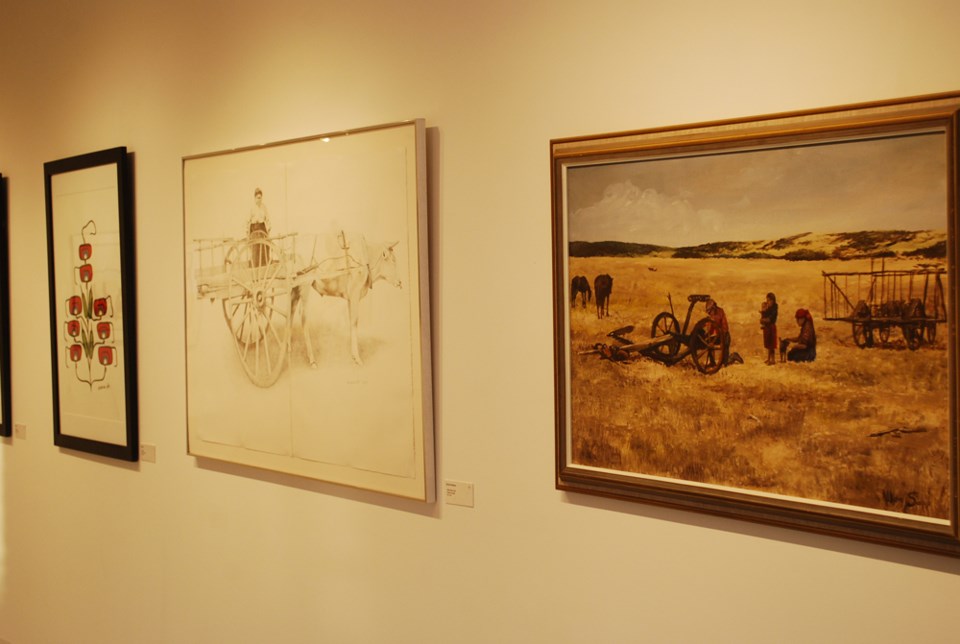For the staff of the Humboldt and District Museum and Gallery, January to March will be an exciting time with four new exhibits making their way to Humboldt, including two that are on display right now in the Humboldt Art Gallery.
The Gallery kicked off the 2016 season with Romie Froese’s exhibit, Vital/Vitality, and contributions from the First Nations University in Regina for their show, AgriCulture, which will be on tour to galleries all across Saskatchewan for three years through the Organization of Saskatchewan Arts Councils (OSAC).
AgriCulture features many different pieces of aboriginal art done by a variety of artists, including an original Allen Sapp, who passed away at the end of 2015.
Some are in a more traditional style, while others have a more modern look.
Even with the minimalist approach to colour and the simplified, traditional look, Myker says the result is absolutely stunning.
“When you look at it, it may not seem like a lot, you have to understand the meaning behind what a lot of symbolism in their portraits and paintings and prints and drawings represent to them in their lifestyles.” Says Niki Myker of the
Humboldt and District Museum and Gallery.
The modern style of aboriginal art did reflect the traditional styles.
“It still represents a lot of their traditional lifestyles, meanings, stories, everything else like that, but you’ll see a lot more use of colour in there.” Says Myker.
Especially in rural Saskatchewan, agriculture was a way of life but urban economy played an equal part. From an aboriginal perspective, agriculture was their only form of production and sustainability.
“For them, it sustained their life in every way possible.” Says Myker.
Aboriginals also paid respect to the land in a very spiritual way. Visitors to the Gallery can see this spiritual side of agriculture in the paintings, says Myker.
Allan Sapp, especially, says Humboldt and District Museum and Gallery Director, Jennifer Hoesgen, was telling a story.
The look of the modern aboriginal paintings do not really differ in the way they look compared to paintings done by European immigrant farmers. Where they do differs is in the meanings behind the imagery.
“For European people, it was just a means of putting food on the table, whereas aboriginal people, it was a means of putting food on their table, making clothing, doing their art, everything.”
Froese, who graduated from Dalhousie University three years ago and paints out of Saskatoon, presented her life-sized oil paintings of athletes as they hone their skills in her Vital/Vitality exhibit.
There is a lot of little details in the muscles structure, says Myker, and she has emphasized certain muscles the athlete uses for their sport.
“It might seem a little distorted but it’s for a distinct purpose.”
There are also repeating objects that Froese features in the paintings. Multiple paintings feature a chair.
“That’s something that is very sturdy in their lives just as much as it grounds them.”
Both exhibits go together well, says Myker, since they portray an everyday lifestyle but they are completely different in their form of artistic style.
Froese submitted her artwork for consideration, which is an important process that is new to the Gallery, says Hoesgen.
This an important reason why the Gallery is bringing in the Canadian Artists’ Representation/Le Front des artistes canadiens (CARFAC) workshop, the Business of Art with Grant McConnell on Feb. 3 at the Gallery.
“A lot of artists have great art,” says Hoesgen, “to take that body of art and present it to a gallery, and present it to a jury...one of the exciting things is we want to help those artists in Humboldt.”
This is one of the first workshops in Humboldt and will cover preparing a portfolio and resumes, information on contracts, copyrighting and insurance and packing and shipping artwork.
Cultivating this artist community is also an important role for the Gallery, says Hoesgen.
“This is one of our first workshops to help artists get together and talk to other artists and really tell us what the artists in the community need. We want to know.”
The gallery is full of submissions until 2017, but Hoesgen says they are willing to work with artists who want to submit for 2018.
OSAC, in partnership with the Cultural Exchange Outreach, is also bringing in another interesting exhibition to the Humboldt Gallery for Feb. 2 called Hello In There/Hello Out There, sponsored by the Humboldt Area Arts Council and Conexus.
The collection includes 15 three dimensional pieces created by seniors in retirement homes in 2014 telling the story of their life on the Saskatchewan prairie and the audio recording of the senior telling their story.
Along with the exhibit at the Gallery, the Museum will also be having programs included with the exhibit. Project artist Chrystene Ells will be coming on Feb. 5 for an artist talk and Feb. 6 there will be a workshop on creating a memory journal.
“We’re encouraging participants to arrive with a senior family member to begin the process of making a memory journal.” Says Leah Terry of the Humboldt and District Museum and Gallery.
Hoesgen says that they are happy that they have the space for both the exhibit and the activities with the Ells.
Hoesgen says they’d really like to see the exhibit expand.
“Not that we’re going to put the Humboldt stuff on the road but if people want to make something and leave it there, we’ll probably put up a table so that it can become a Humboldt show.”
The Museum and Gallery really encourage people to register for the workshop by calling the Museum.



